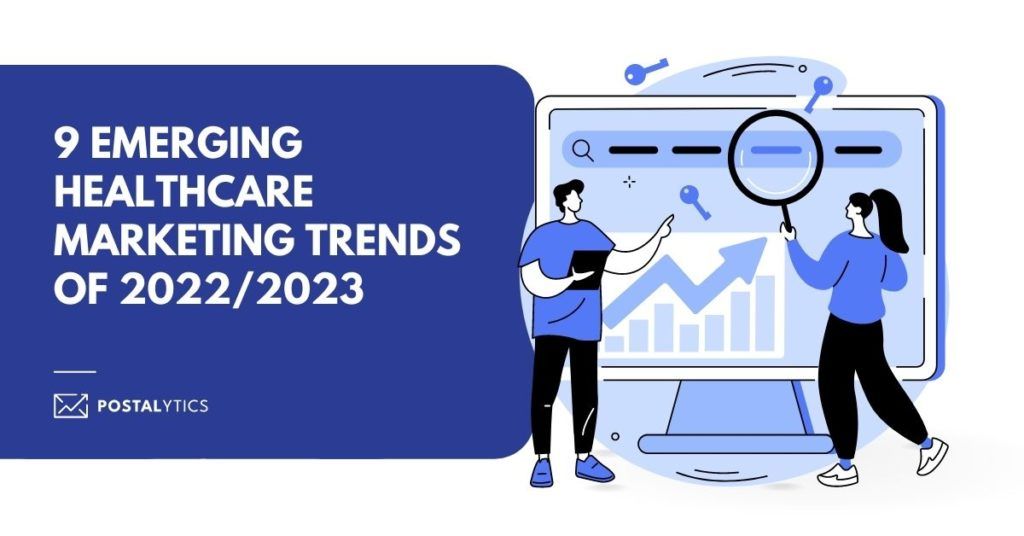
Emerging trends can help marketers uncover their next-best move. And as the leading direct mail marketing automation platform, we spend a lot of time studying marketing trends. So, let’s dive in and analyze some of the fastest-growing healthcare marketing trends.
Marketing trends define how the entire industry looks and feels, encouraging marketers to use innovative and integrated marketing platforms. Let’s take Postalytics, for example.
Postalytics is a direct mail automation platform that allows marketers to cut through the digital noise and stay on top of emerging healthcare marketing trends. You can also easily connect Postalytics to the rest of your tech stack, including your healthcare CRM to sync all the data. Learn more about Postalytics in the demo.
And once you’re ready, let’s take a closer look at the emerging healthcare marketing trends of 2024.
What We’ll Cover
- #1 Personalization in healthcare marketing
- #2 Advanced marketing tech is all around us
- #3 Integrated marketing campaigns lead the way
- #4 More targeted data for healthcare marketing
- #5 Reviews will continue to drive sales and rankings
- #6 Video content continues to drive engagement
- #7 Local SEO for healthcare organizations
- #8 Increased privacy concerns are growing into tangible legislation
- #9 Content marketing has been changing
- Final Thoughts on healthcare marketing trends
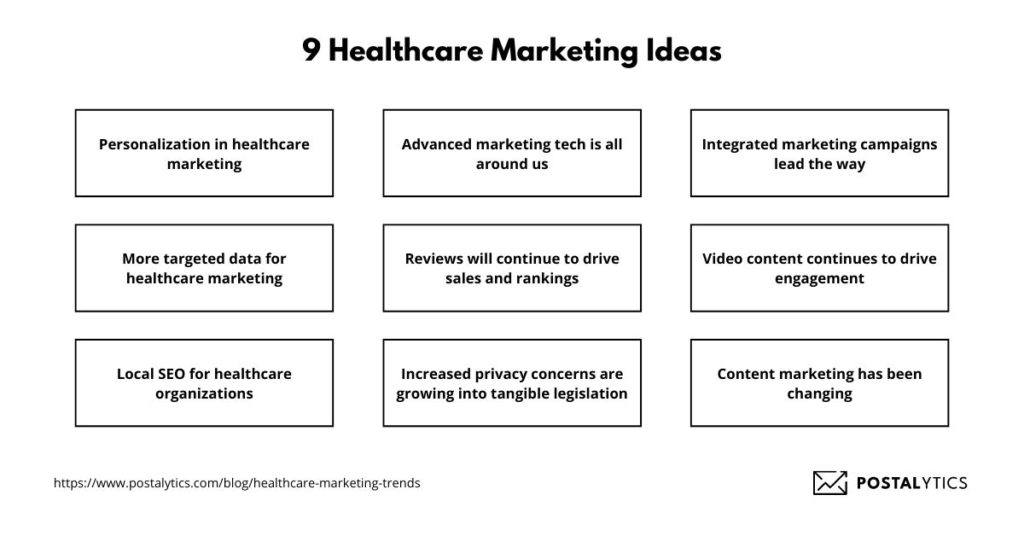
#1 Personalization in healthcare marketing
Personalization is an emerging healthcare marketing trend.
Consumers don’t want to be just another number. So, marketers have started personalizing their reach to connect with patients and healthcare professionals.
Personalized marketing strategies have significant benefits for both consumers and businesses. Choosing the right techniques and tools will help you maintain cohesion and consistency on all channels, leading to higher brand loyalty and stronger communities.
Besides that, personalization is also effective and beneficial if you want to drive constant engagement. Strategically designed personal interactions help healthcare consumers understand which brand can offer them the correct reliefs they need. This, again, can create loyalty among customers, getting them to prioritize your offer in the future.
One of the most impactful and intuitive personalization tactics is creating direct mail drip campaigns. Simply put, marketers can connect their CRM and define triggers that send out personalized postcards and letters. Triggers are easily created in your Postalytics account and can help you connect healthcare professionals with their patients.
Since sending the correct type of mail at the right time is vital, it’s best to automate the process and avoid any opportunity for human error. This will help nurture your clients and compel them to benefit from your medical practices.
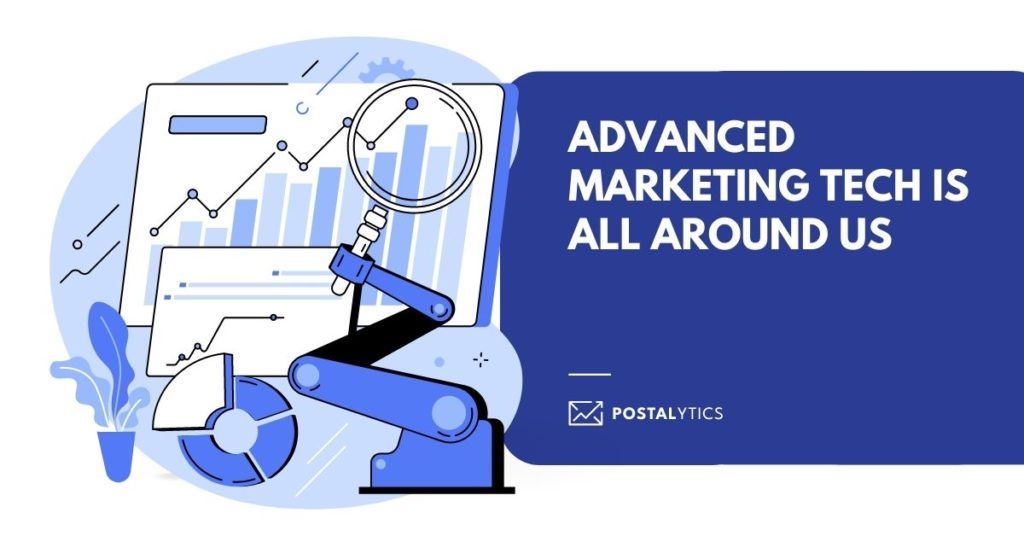
#2 Advanced marketing tech is all around us
Modern technologies are becoming more practical, faster, and efficient. Not to mention, innovations and upgrades in technology are making life faster, easier, better, and of course, more entertaining. With increasing awareness surrounding tech use in almost every industry, healthcare marketers have also introduced advanced high-tech tools and software. Such technology is intuitive, easy to handle, and offers more efficient results. One of the most promising and highly targeted marketing innovations is direct mail automation.
Automations and carefully developed tech integrations can help marketers build Omni-channels and create several touchpoints, leading their customers to the correct solution for their problems.
Running traditional direct mail campaigns has never been easy, though. Teams of professionals had to perform the entire process manually – from crafting, designing, and printing each piece to posting the entire campaign. This requires time, effort, and labor, which used to cost a lot of money. Even if healthcare organizations opt-in for online tools, there are always minimum and maximum limits. Still, they require a lot of work across a steep learning curve.
Postalytics solves all these problems and has introduced a breakthrough technology that reduces manual work in the marketing process. Marketers prefer CRM integration which can sync all the electronic health records from your CRM. This way, marketers can send only targeted promotions on-demand. For example, you can easily execute a campaign where you retarget cold leads for healthcare, one piece at a time. Finally, you can track each piece from your dashboard and get real-time information about the performance of your campaign.
This helps nurture your leads and offers them a healthcare solution when they’re confused or hanging between multiple options. Triggered direct mails also offer customer loyalty and long-term consumer and business relationships.
You can forget about printing, assembling, sorting, and posting – the most attractive benefit. Hence, designing and creating marketing material is easy with Postalytics.
#3 Integrated marketing campaigns lead the way
Have you ever wondered why a brand with a serious marketing budget and great services and products fails to gain brand recognition and maintain profitable sales? Unfortunately, this happens all the time.
The top reason is usually the lack of a cohesive campaign and tech integrations. The brand fails to deliver ROI-positive campaigns across all marketing channels, often spending much more money in the long run than they ever would if they used an integrated tech stack. This creates confusion and doubts among healthcare marketers, which trickles down to medical professionals and their patients. Therefore, fewer people prefer to build a business relationship with you.
If you want to boost sales, attract new patients, and turn cold leads into customers, you need to plan for integrated healthcare marketing. Deliver the same message across all your marketing channels and have an ROI-positive way to stay on track with your marketing goals.
It can easily create a top-of-mind awareness that encourages prospective patients to reach out to you whenever they need medical help.
Here are a few tips for building an integrated marketing campaign.
- Determine your marketing goals
- Evaluate all your marketing tech (MarTech)
- Find out what tools get along with others
- Eliminate tools that create clutter in your process
- Integrate your marketing tech to reach pre-defined goals seamlessly
Postalytics allow businesses to run integrated healthcare direct mail marketing campaigns on their platform.
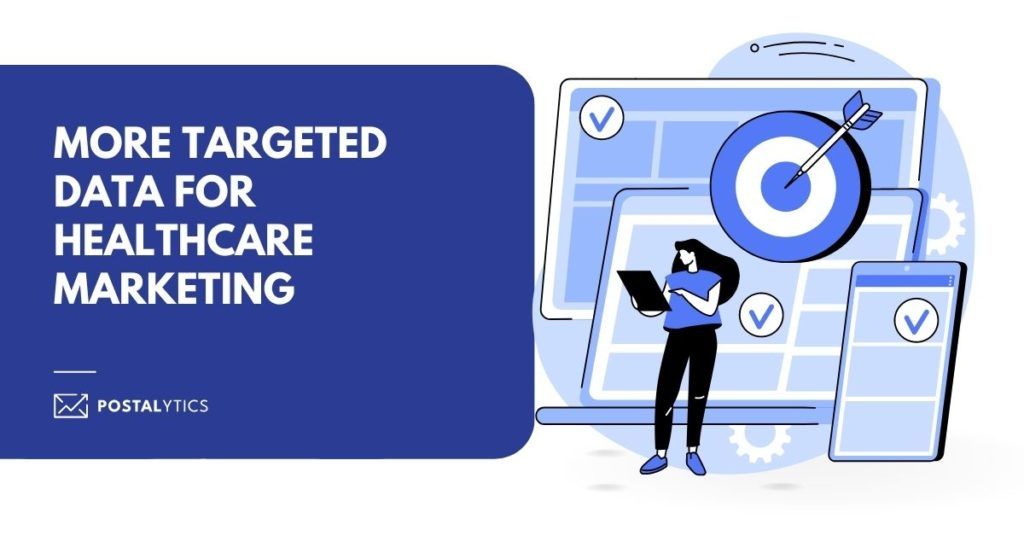
#4 More targeted data for healthcare marketing
Many healthcare marketing case studies prove that medical marketing is challenging and tricky.
Your audience will be relatively more serious and highly focused, whether you have a healthcare facility, clinic, pharmacy, or medical institution. Besides that, there is a broad healthcare target audience that may or may not requires your services. Cutting out the noise and targeting the right audience in the right way is crucial.
Using targeted data to design and run marketing strategies needs to be your priority. But how can you do this? Healthcare companies using CRMs can streamline a highly targeted marketing strategy. You can use customer data to find who needs what kind of product or service.
However, analyzing and turning the data into an ROI-positive promotion can be difficult without the right technology. One of Postalytics’ amazing features is that healthcare marketers can integrate their CRM, like HubSpot and Salesforce. These integrations will help you turn your data into personalized and highly-targeted pieces of direct mail.
Integrations save from manually feeding data to marketing tools and software. You can further personalize your mail with QR codes that link to personalized pages leading the patient closer to their remedies.
#5 Reviews will continue to drive sales and rankings
Healthcare consumers want to understand the pros and cons of the services or products before they actually use them, especially regarding medication or changing their life-long family practitioner (FP).
Reviews come in different shapes and forms. For some, a good review is a recommendation from a friend or a doctor. And for others, they need to surf the internet and read up on personal experiences before they make a decision.
While it’s true that many companies offer detailed information, promises, and even guarantees about their services, hearing about someone’s personal experience can make a great difference.
They need to know what they may face changing a medication or a doctor. Online reviews can give them information about your healthcare facility, services, or products. It can connect them with a broad community that shares similar pains and interests.
So, prioritize collecting reviews on different platforms to improve your visibility on the internet and attract more clients. Simultaneously, try to offer the best service possible, so others will recommend you as the remedy or a solution.
One thing that might come your way to rank high in the market is bad and lesser reviews. To manage bad reviews, you can take the following steps.
- Offer excellent communication channels to customers
- Stay available for consumers 24/7
- Ask customers for feedback
- Improve upon the collected feedback
- Promise to avoid mistakes in future
- Offer a discount if you fail to keep up with your promises
Some tips that help you collect significant reviews.
- Ask your consumers to give you reviews every time they purchase
- Send them an email or a piece of mail with a pURL linking to a review site
- Add options like ratings and default messages so that customers can give reviews with as little friction as possible
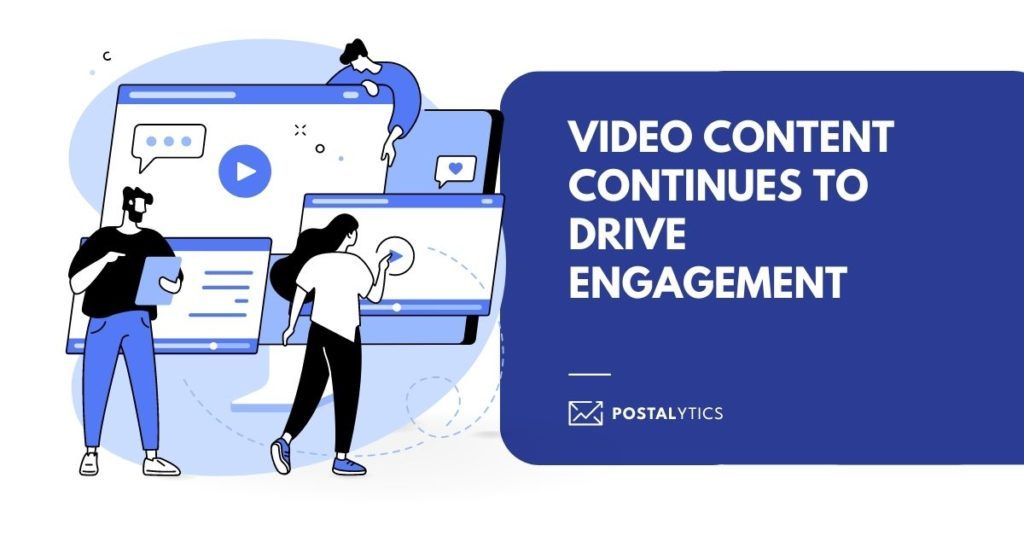
#6 Video content continues to drive engagement
Marketers have been incorporating videos in their marketing since the dawn of television.
Videos have become essential content that attracts a target audience. They’re a great way to explain your services or products. It offers a visual representation of your company or product, allowing customers to easily understand its features and components.
Customers only buy your services or products when they understand how they work and how they can benefit them. Since videos are a very stimulating and compact way to tell your story, you can talk about your product in a very attractive and appealing way. The freedom to put your emotions and create anything attractive allows marketers to engage with more patients.
The reason why videos have become so influential is obvious. Creating videos has never been easier. It’s so easy for a teenager to film something good with a smartphone and reach millions of potential viewers across the US and Canada. Our devices support video in easy and quality formats. So, the reason why video is continuing to outperform is that technology has made it easy to create and consume.
Marketers are taking note. You can share the video content of your healthcare organization on different platforms. Based on your created content, you can post the videos on different social media platforms, send them in email campaigns, share them on your website or even send them on a postcard with QR Codes and pURLs. Make sure to share the videos on a platform where you can find more members of your target audience.
Additionally, creating an informational video discussing all the essential aspects of your healthcare organization is important for driving engagement and increasing brand visibility.
#7 Local SEO for healthcare organizations
Local SEO has been looming for years. With the latest digital privacy laws changes and legislative uncertainty ahead, marketers have been doubling down on search engine optimization (SEO).
SEO is a digital bloodstream of sorts. Your website needs a constant stream of traffic to function and stays healthy. Without SEO, getting traffic is either expensive (PPC) or highly unlikely (most websites get no traffic). And if you’re starting out, ranking for some of the popular short-tail keywords is almost impossible. So, healthcare organizations will focus on more targeted and long keywords and problems to connect with their patients and communities at large.
Local SEO brings more legs to any SEO strategy. It’s generally less competitive because you’re competing only with the local community instead of the entire world. Local SEO mainly revolves around location instead of 1000s of search-engine-defined ranking factors.
Think of local SEO as any query that ends with “…near me” or “in Boston.” This can be a query like “pharmacy near me” or “emergency room in Boston.”
If you’re offering a healthcare service in a specific location, you’re guaranteed to rank highly.
Local SEO also spells urgency. If someone needs a physician or a pharmacy quickly, they’ll look for one that is near them. They care only that it’s close, often putting reviews and everything else on the backseat.
Here are some tips you can practice for optimizing your business for local SEO.
- Create an account on Google My Business (GMB)
- Optimize your GMB to include the essential information
- Gather customer reviews on GMB
- Consider local link building on your website
- Optimize your website for mobile devices
- Localize your website content with local keywords
Since people look up things on the internet before they make any decisions, most of your target audience will search for a local healthcare organization. Using local SEO, you can direct them to your practice and help them find their remedy.
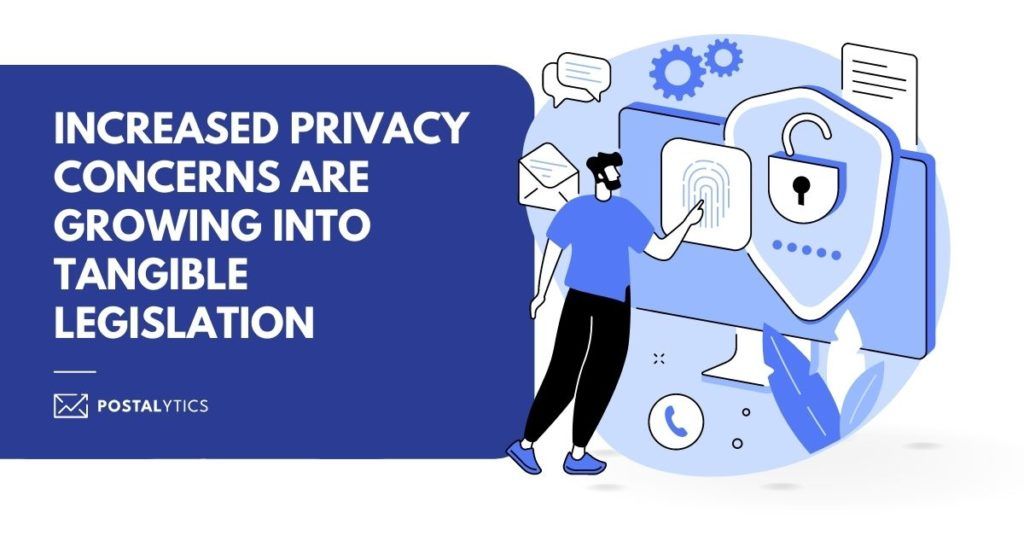
#8 Increased privacy concerns are growing into tangible legislation
Social media has become a crucial marketing tool in the past few decades.
Marketers and companies welcome the opportunity to connect with their customers and create thriving communities. This encourages businesses to use them as an essential medium to advertise and market products and services.
Legislators in the United States, Canada, and Europe have pushed big social media corporations to restructure their privacy policies. Regulations have been changing on a frequent basis as regulators learn how to create a more inclusive playing field for SM companies.
This has impacted healthcare advertising trends. In 2024, you can expect to see new sets of privacy laws regulating the use of social media. New rules will increase the time it takes to connect with larger audiences on social media. On top of that, you need to be careful about what you share with followers and how you sell products. Anything violating your audience’s privacy can result in a permanent or temporary ban, snowballing into even more trouble down the road.
Besides keeping customers secure, enhanced privacy policies on digital media platforms will benefit businesses. When people know that the products or services you’re trying to sell have passed multiple phases of verification, people will be less skeptical about purchasing your services. With more trust, you can build long-lasting relationships with your communities.
#9 Content marketing has been changing
Content marketing no longer means stuffing your website with keywords and pumping random articles written by your new intern.
Content has changed over the years and continues to evolve. Content marketing strategies are changing because the way we interact with others on the internet is also changing.
Consumers are more likely to self-educate themselves before buying a product or hiring a service. Individuals are going to consume relevant content before they’re sure of their buying decision. Healthcare marketers have started creating multiple touchpoints (from 6 to 9 touchpoints on average) for their customers. Each touchpoint comes in a different format, like email, social media posts, user-generated discussions, postcards, letters, etc.
Multiple touchpoints are essential to continue driving engagement and sales for any sort of healthcare business.
Also, technology has immensely improved. Now, we can notice unique marketing options on different platforms, such as letter-embedded QR codes, social media stories, reels, short videos, GIFs, tagging options, and hashtags. Technology advancement has made the content concise, precise, and impactful.
As always, more informative, valuable, and easy-to-understand content is in high demand. Since your content will be accessible to many people, it increases your potential to connect with patients who need your products and services.
Final Thoughts on healthcare marketing trends
Following the right healthcare trends and using the right tools will boost your brand recognition and help your stay connected with people that need your solutions.
Thinking about your healthcare marketing today and getting ready for the upcoming trends will help you cut through the noise and stay ahead of the curve.
Once you’re ready to incorporate direct mail marketing solution into your marketing mix, and connect it to your favorite marketing tech, open a free Postalytics account. Let us show you the easy way to manage all the integrations, templates, automation, printing, sending, and tracking of your direct mail campaigns.
About the Author

Dennis Kelly
Dennis Kelly is CEO and co-founder of Postalytics. Dennis joined Boingnet, the predecessor to Postalytics, in 2013. Boingnet was focused on providing print and direct mail marketing service providers the ability to add digital marketing channels to their direct mail campaigns. Postalytics is Dennis’ 6th startup. He has been involved in starting and growing early-stage technology ventures for over 30 years and has held senior management roles at a diverse set of large technology firms including Computer Associates, Palm Inc. and Achieve Healthcare Information Systems.
